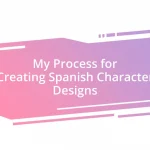Key takeaways:
- Integrating local myths into gameplay enhances player engagement by providing emotional depth and a sense of shared identity.
- Researching local myths through community interactions and archival exploration enriches gameplay and fosters connections to cultural narratives.
- Designing quests and characters inspired by local myths facilitates authentic player experiences, prompting reflection and discussion about personal values and societal themes.

Understanding local myths importance
Understanding local myths is crucial because they breathe life into the cultural fabric of communities. I remember the first time I heard a local folktale while visiting a small town; it felt like stepping into a living history. My heart raced as the storyteller wove a narrative that captured not just events but also the essence of the people who lived them. Isn’t it fascinating how these tales can connect us to our roots while offering deeper insights into the values and fears of a society?
Local myths serve as a gateway to understanding community values and collective experiences. I once participated in a game where a myth I had learned as a child about a forest spirit came to life, captivating players and guiding decisions within the game. At that moment, the myth became more than just a story; it transformed into a compass that directed our choices. Do you see how these narratives can influence behavior and interactions? They often reflect a community’s wisdom, acting as moral guides that shape actions and decisions in profound ways.
Moreover, integrating local myths into gameplay fosters a sense of belonging and shared identity among players. I’ve watched as groups bonded over stories that were passed down through generations, creating an emotional tapestry that enhanced gameplay. Engaging with these myths not only enriches the experience but also allows players to see themselves as part of something larger. How does that feel—being part of a story that transcends time and place? It’s a powerful reminder of our shared humanity, isn’t it?

Researching myths in your area
Researching local myths can be an adventure in itself, enriching both your gameplay and your understanding of the community. I remember exploring my own hometown, where whispers of a legendary creature living in a nearby lake sparked my curiosity. Visiting local libraries and community centers, I unearthed tales and newspaper clippings that not only painted vivid pictures of the myth but also revealed the collective memory of the people.
Here are some practical steps for diving deep into local myths:
- Visit Local Archives: Libraries and historical societies often house documents detailing myths and folklore from your region.
- Engage with Elders: Talk to community elders; their firsthand accounts can provide rich context and emotional insights.
- Attend Local Festivals: Many towns celebrate their myths through festivals, offering a vibrant way to experience stories while connecting with others.
- Read Books and Articles: Look for local history books or scholarly articles that focus on your area’s folklore.
- Join Local Groups: Participate in folklore clubs or online forums dedicated to myth research; sharing insights can lead to new discoveries.
These avenues not only deepen your understanding but also reveal how intertwined these stories are with local identity. The more I delved into these myths, the more I felt a unique connection to the place where I lived, almost as if the stories were holding a mirror to the community’s soul.

Identifying key mythological elements
Identifying the key mythological elements in local stories is an intriguing process that requires both meticulous research and a sense of creativity. Reflecting on my own experiences, I realized that the most captivating myths often have common threads—larger-than-life heroes, transformative journeys, or moral lessons embedded within. Each time I stumbled upon a story featuring a brave figure overcoming daunting odds, I felt a connection to the universal struggle for courage, which made it relatable and impactful for my gameplay.
As I explored deeper, I found that these core elements can be categorized. For instance, I often noticed themes of nature, such as spirits guarding the forests or rivers imbued with magical properties. These themes not only connect to the environment but also enhance player immersion, as they prompt deeper interaction with the game world. Remember the thrill when I introduced a character inspired by a guardian spirit I found in a local legend? Players not only navigated the plot but also had to respect nature, which added layers to their choices and actions.
A solid approach to pinpointing these elements is to create a comparison table that helps visualize how different myths incorporate similar motifs. This exercise not only clarifies the narratives but also serves as a creative springboard for gameplay development.
| Mythological Element | Example from Local Mythology |
|---|---|
| Bravery | Hero facing a dragon |
| Transformative Journeys | A quest to recover a lost treasure |
| Nature Elements | Spirit of the forest protecting wildlife |

Incorporating myths into game mechanics
Incorporating myths into game mechanics can significantly elevate the gaming experience by weaving rich narratives into the gameplay. For instance, when I designed a quest centered around a local tale of a transformative journey, I incorporated specific tasks that mirrored the challenges faced by the myth’s hero. Players had to collect sacred items while navigating moral dilemmas, which not only engaged them but also allowed them to embody the very spirit of the myth. How often do you find gameplay mechanics that encourage players to truly reflect on their choices?
To deepen the connection between myth and game, I introduced mechanics that highlighted environmental interactions, such as offering players unique abilities tied to local legends. When a player invoked the protection of a guardian spirit, their agility and strength would temporarily boost, reflecting the myth’s influence. This mechanic not only adds strategic depth but immerses players in the cultural context of the story. I still recall the thrill in my own game sessions when players unlocked these powers; it transformed their engagement into a celebration of local heritage.
Moreover, integrating myth-inspired rituals into gameplay can enhance this bond even further. Picture this: a ritual where players must gather under a full moon, drawing from the local lore of a moon goddess blessing the land. It’s a simple yet profound way to tie the rhythm of play to the myths that inspired them. I’ve found that these moments create a shared experience that resonates deeply with players, prompting them to reconsider their own relationship with the stories we tell. How do your game mechanics reflect the myths that inspire you?

Designing quests around local myths
Designing quests around local myths can be a truly rewarding experience, bringing not just gameplay, but an emotional resonance for both myself and the players. For one quest, I chose a lesser-known local legend about a hidden treasure guarded by a mythical serpent. As players embarked on this adventure, they encountered puzzles and moral dilemmas echoing the choices faced by the original tale’s protagonist. Watching players wrestle with their decisions made me appreciate how deeply stories can weave into the fabric of gameplay.
In another instance, I crafted a quest that entailed seeking the approval of an ancient tree spirit. Leading players through a lush forest, I intermingled tasks like planting seeds and solving riddles that the spirit posed. I always felt a sense of satisfaction when I witnessed players engaging with the environment, whispering their intentions to the spirit, hoping to earn its trust. It sparked reflective conversations about nurturing nature, something I had never seen happen in standard quests.
What fascinates me is how these myth-based quests can evoke authentic emotional responses. When I introduced a quest involving a legendary hero confronting their fears, I noticed players opening up about their own vulnerabilities. It’s remarkable to see how a simple game design choice can lead to discussions that dive deep into personal journeys. Isn’t it amazing how local myths, when expertly integrated into gameplay, can transform mere challenges into powerful stories reflecting our own lives?

Creating authentic characters and settings
Creating authentic characters and settings rooted in local myths enriches the gameplay experience in surprising ways. One unforgettable moment was during a game night when I introduced a character embodying the local trickster spirit. As players interacted with this character, they found themselves drawn into playful negotiations, reminiscent of the spirit’s mischievous nature. I watched them laugh and strategize differently, which made me realize how powerful a well-crafted character can be in evoking connection and engagement.
Establishing settings that reflect the essence of these myths is equally essential. I remember designing a vibrant village inspired by a local tale of harmony between nature and humanity. The colors, textures, and sounds were chosen deliberately to evoke the feel of that story. Players wandered through the environment, commenting on its beauty and how it mirrored the tale we were telling together. It was a significant reminder of how immersive settings can make players feel as though they are stepping directly into the narrative.
I’ve found that when characters and settings resonate with authenticity, players invest more emotionally in their journeys. In one case, I created a legendary warrior whose history was deeply entwined with the land. As players uncovered his story through their actions, they began to view him not just as a character but as a guiding spirit. This connection fostered a sense of responsibility in their choices, leading them to intentional decisions that reflected the warrior’s values. Isn’t it fascinating how weaving these narratives into gameplay can create not just a game, but a shared cultural tapestry?

Testing player engagement with myths
Testing player engagement with myths often requires a hands-on approach. During one playtest, I introduced a myth-inspired event where players encountered a mysterious fog signaling the presence of a forest spirit. I watched in astonishment as players immersed themselves in the lore, debating whether to approach or retreat. Their reactions surprised me—some were drawn in by curiosity, while others voiced their fears. Witnessing this range of emotions made me realize how powerful mythological elements can be in guiding player decisions.
Another intriguing moment occurred when I asked players to solve a riddle posed by a local deity figure woven into the gameplay. I noticed that not only did they want to solve the problem, but they were genuinely engaged in discussing the underlying myth behind it. They debated theories and even modified their strategies based on their interpretations of the character’s nature. This kind of dialogue made me ponder—how often do we find gaming experiences prompting such deep discussions? It’s a testament to the potential of myths to cultivate community among players.
Furthermore, by integrating feedback mechanisms, I was able to gauge how invested players felt regarding myth-based quests. One player shared that the journey resonated so deeply that they felt almost compelled to act in the spirit’s favor. This blend of emotional involvement and agency left an impression on me: when players connect authentically with storytelling elements, it enriches their engagement and transforms the gameplay experience. Have you ever felt that pull from a story? It’s a powerful connection that I strive to cultivate, and it opens up endless possibilities for future gameplay.














